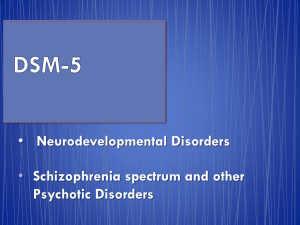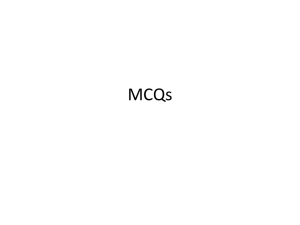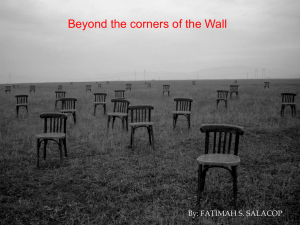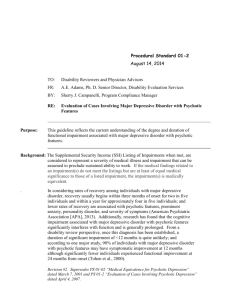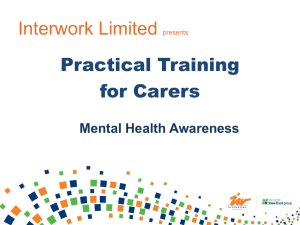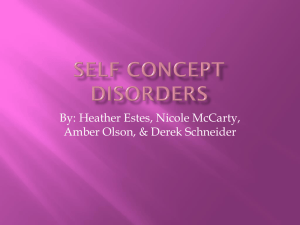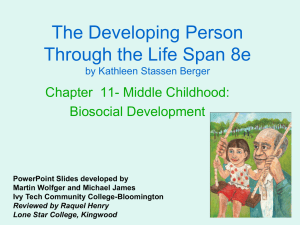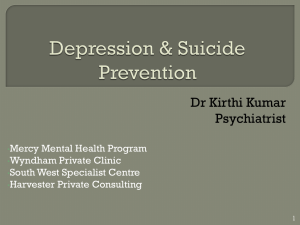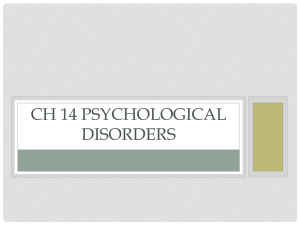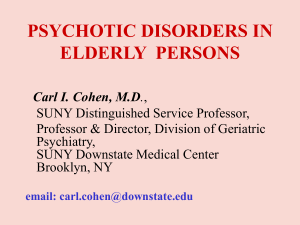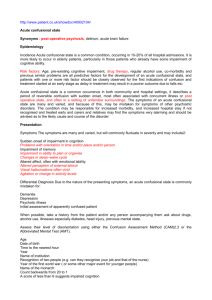DSM-5 Psychotic Disorders
advertisement
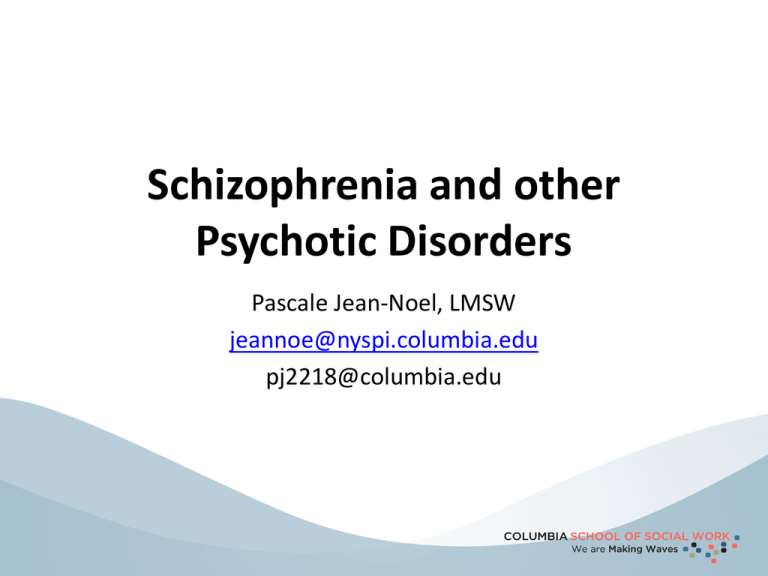
Schizophrenia and other Psychotic Disorders Pascale Jean-Noel, LMSW jeannoe@nyspi.columbia.edu pj2218@columbia.edu Schizophrenia & other Psychotic Disorders DSM IV • Schizophrenia: Must have 2 Criterion A symptoms with disorganized behavior and positive symptoms but can only have one and has five subtypes (paranoid, disorganized, catatonic, undifferentiated, residual) • Delusional Disorder: Presence of well systemized, non bizarre delusions accompanied by affect appropriate to the delusion and occurring in the presence of a relatively well preserved personality • Schizoaffective Disorder: An uninterrupted period of illness during which, at sometime, there is either a major depressive episode, a manic episode, or mixed episode concurrent with symptoms that meet criterion A • Shared Psychotic Disorder: Presence of a delusion that develops in the context of a close relationship with another person, who already has an established delusion • Psychotic Disorder NOS: includes psychotic symptomology however inadequate information to make a specific diagnosis Schizophrenia & other Psychotic Disorders DSM IV • Schizophreniform Disorder: the same • Brief Psychotic Disorder: the same • Psychotic Disorder due to Medical conditions: the same • Substance Induced Psychotic Disorder: the same Schizophrenia Spectrum and Other psychotic Disorders- DSM-5 • • • • • • • • • • Schizotypal Personality Disorder Schizophrenia Schizoaffective Disorder Schizophreniform Disorder Delusional Disorder Brief Psychotic Disorder Catatonia Features Specifier Substance/Medication-Induced Psychotic Disorder Psychotic Disorder due to another medical condition Other Specified Schizophrenia Spectrum and Other Psychotic Disorder • Unspecified Schizophrenia Spectrum and Other Psychotic Disorder Schizophrenia- DSM 5 • Must have 2 Criterion A symptoms :delusions, hallucinations, or disorganized speech (positive symptoms). • Subtypes eliminated because of low reliability and poor validity and now used to provide further detail to diagnosis Specifiers of Schizophrenia- DSM 5 Specifiers to be used after year duration of the disorder First episode, currently in acute episode, First Episode, currently in partial remission, First Episode, currently in full remission, Multiple Episodes, currently in acute episode, Multiple Episodes, currently in partial remission, Multiple Episodes, currently in full remission, Continuous, Unspecified, Catatonia Schizoaffective Disorder • An uninterrupted period of major mood episode (manic or Depressive) is concurrent with positive symptoms of schizophrenia (Criteron A) • Hallucinations or delusions must be present for 2 weeks or more in the absence of prominent mood symptoms, but mood symptoms must be present for the total duration of the illness • Specifiers: Bipolar type- marked by current or previous manic syndrome Depressive type- marked by the absence of any manic syndromes Other Specifiers of SchizoeffectiveDSM 5 Specifiers to be used after year duration of the disorder: First episode, currently in acute episode, First Episode, currently in partial remission, First Episode, currently in full remission, Multiple Episodes, currently in acute episode, Multiple Episodes, currently in partial remission, Multiple Episodes, currently in full remission, Continuous, Unspecified Delusional Disorder- DSM 5 • Presence of well systemized, non-bizarre/bizarre delusions accompanied by affect appropriate to the delusion and occurring in the presence of a relatively well preserved personality • Bizarre content includes delusions that are implausible, not understandable, and not derived from ordinary life experiences (ex. belief that stranger removed his/her organs and replaced them with someone else’s organs) Other Specifiers of Delusional Disorder- DSM 5 Specifiers to be used after year duration of the disorder First episode, currently in acute episode, First Episode, currently in partial remission, First Episode, currently in full remission, Multiple Episodes, currently in acute episode, Multiple Episodes, currently in partial remission, Multiple Episodes, currently in full remission, Continuous, Unspecified Schizophreniform Disorder- DSM 5 • Patients who present with typical schizophrenia symptoms but who have been ill for at least 1 month but less than 6 months Substance/Medication-Induced Psychotic Disorder- DSM 5 • Substance involved is capable of producing presence of hallucinations and delusions • Specify if • With onset during intoxification • With onset during withdrawal Psychotic Disorder Due to Another Medical Condition- DSM 5 Evidence from a physical examinations or labs that distorted perceptions (hallucinations/delusions) result from a medical condition and cannot be explained by a mental disorder. Specify if With Delusions, or Hallucinations Catatonia Disorder Due to Another Medical Condition -DSM 5 Dominated by 3 or more of the following: Catatonic Stupor, Catalepsy, Wavy Flexibility, Mutism, Posturing, Stereotypy, Mannerism, Echopraxia, Negativism, Agitation, Grimacing Catatonia Associated with Another Mental Disorder (Catatonic Specifier) -DSM 5 • dominated by 3 or more of the following Stupor, Catalepsy, Waxy Flexibility, Mutism, Negativism, Posturing, Stereotypy , Agitation, not influenced by external stimuli, Grimacing Other Specified Schizophrenia Spectrum and other Psychotic Disorder- DSM 5 • Persistent auditory Hallucinations occurs in the absence of any other features • Delusions and significant overlapping mood episodes- persistent delusions with periods of overlapping mood episodes that are present for a substantial portion of the delusional disturbance • Attenuated psychosis syndrome- characterized by psychotic like symptoms that are below a threshold for full psychosis (symptoms less severe where insight and judgment maintained) • Delusional symptoms in partner or individual with delusional disorder- delusional material from dominant partner provides content for delusional belief by the individual who may not otherwise entirely meet criteria for delusional disorder Schizophrenia Paranoid type-DSM 1V Schizophrenia Multiple episodes, currently in acute episode–DSM 5 Ms. P a 26 year old single woman was brought in for a consultation by her parents because of reoccurrence of her psychotic symptoms and generally poor functioning. She lives at home with her parents and last worked 5 years ago as administrative assistant. She was hospitalized 3 times in the past 5 years. Ms. P currently has a reoccurrence of the delusion that she can control the behaviors of others through her breathing and that people can read her mind. She is convinced that she is being watched, followed, complains of being confused and at times may repeat phrases without meaning to others. She admits to hearing threatening voices stating that they will kill her for having the power to hurt others. She lacks motivation and hesitate to participate in social activities due to increased paranoia that everyone around her know her thoughts and the power she has to read minds. What is the significance of DSM 5 revisions to social work Practice?
